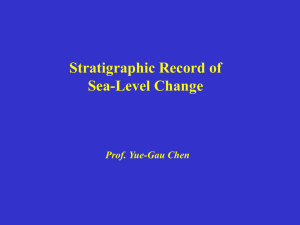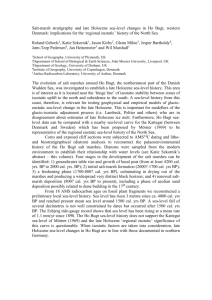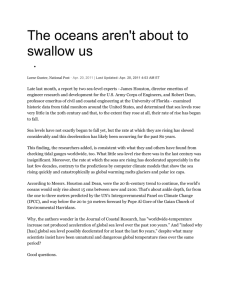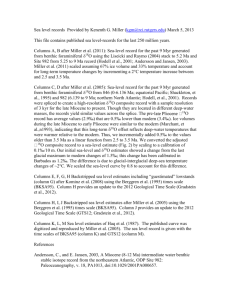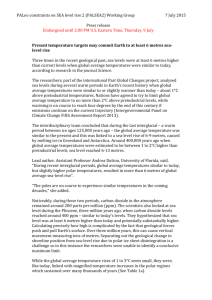Basin Analysis Lectures - LSU Geology & Geophysics
advertisement
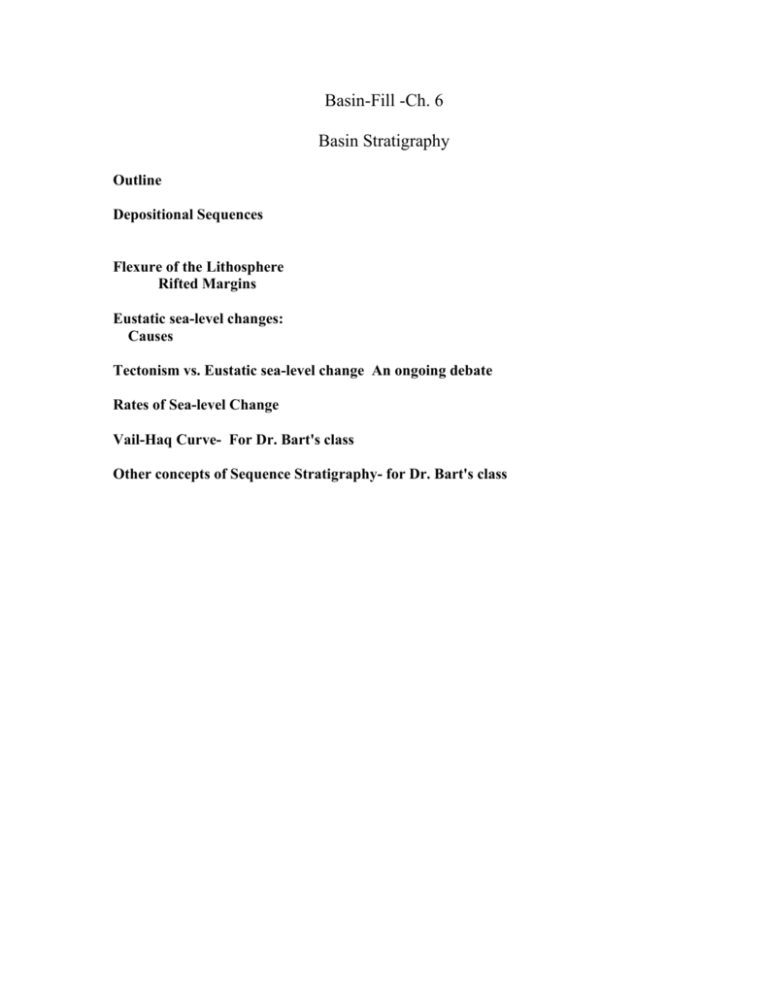
Basin-Fill -Ch. 6 Basin Stratigraphy Outline Depositional Sequences Flexure of the Lithosphere Rifted Margins Eustatic sea-level changes: Causes Tectonism vs. Eustatic sea-level change An ongoing debate Rates of Sea-level Change Vail-Haq Curve- For Dr. Bart's class Other concepts of Sequence Stratigraphy- for Dr. Bart's class Depositional Sequences (Figs. 6.1 and 6.2) Stratigraphic boundaries are fundamentally caused by discontinuities in the process of sedimentation. But, first the potential of preservation of a sedimentary unit must be established. Accommodation space must be created during basin subsidence in which to trap and preserve the sediments. Sedimentary packages bounded by erosional surfaces are known as depositional sequences. They occur at different scales and are of different sizes. The standard depositional sequence is thought of as a unit of rock that is deposited by the same laterally related process (genetically related) and is bounded by surfaces of non-deposition or surfaces of erosion. The causes of erosion can be related to a relative sea-level drop. This can be caused by a true global sea-level drop or by a relative rise of the land by tectonic causes. And the opposite is true too that a relative sea-level rise may be created by either a true global sea-level drop or by tectonic subsidence. A common belief that I think is contentious is that depositional sequences are formed in response to only changes in eustatic (global) sea-level. A third factor that is responsible for the generation of depositional sequences is the relative supply of sediment. If sediment fills a basin faster than it can sink that will appear as a relative sealevel rise. The importance of these sequences is that they are globally correlatable because eustatic sea-level changes are global by their nature and synchronous! Internal geometries of depositional sequences allow us to develop a history for the causes of growth of the sequences. For example, onlap is the landward advance of successive beds over an underlying surface. Offlap is basinward shift of successive beds over an underlying surface. Downlap is the successive termination of a bed at its lower reaches against a surface Toplap is the successive termination by pinching out of the top of beds Erosional truncation is the decapitation of the tops of beds and marks the end of a sequence and start of a new one. Flexure of the lithosphere Rifted Margins If the lithosphere is elastic in a simple-minded way, then as sediments fill a basin they will be able to onlap greater distances than if the basin were to subside in Airy fashion. For example, during rifting the elasticity is very low. The subsidence is fault controlled and the units of in-fill can not reach out beyond the depression. As the lithosphere cools and strengthens, the units can then onlap more landward units, forming a classical steers-head geometry. (Fig. 6.3) Foreland Basins FB are usually wedge-shaped. The width and depth of the basin depend on the elastic strength of the lithospherel (Fig. 6.5) Peripheral and Retro-Arc foreland basins. Eustatic sea-level changes: Some causes (1) Cretaceous experienced a 200-m higher global sea-level stand. Just after the breakup of Gondwana, the ocean basins were on average young, and shallow because the lithosphere was young and highstanding displacing water onto the continental shelves. (2) There are other causes for sea-level changes such as removal of water from the oceans and transfer of water to ice sheets. Today's sheets store a potential water depth increase of 60-75m, or a sea-level rise of 50 m. Pleistocene ice-sheet melting accounted for 100-m rise. During melting sea-level rise is about 10 mm/yr. It is most important to note that a sea-level rise of say 10 m means that more than 10 m of water have had to be placed into the oceans because water depresses the ocean floors (Fig. 6.16). That is, for every meter in sea-level rise there have been 1.4 m of water added. (3) Water-volumes seem constant over geologic time. Water is cycled into and out of rocks, e.g. hydrothermal activity, metamorphic dehydration. (4) Sediment infilling basins can displace water and create a sea-level change. Sediment is also lost at subduction zones. Each see mto be in balance. Tectonism vs. Eustatic sea-level change An ongoing debate Data to develop the stratigraphic-based global model for sealevel change comes to us from the seismic world. But most of the data that has been used to develop the model is unpublished. Establishing its veracity will be difficult. Most of the world's data was taken from passive margins, where tectonism is absent. So what happens when tectonic subsidence exists? We don't really know. Norway is experiencing a relative sea-level drop. It is accepted that the first-order sea-level changes (225-300 Ma) are driven by mid-ocean growth. Second-order cycles (10-80 Ma) include rift-drift transitions of Airy-to-Flexure transition. However, the Oligocene abrupt sea-level fall (greenhouse-to-ice-house) can not be explained by flexure alone. Third-order cycles (1-10 Ma) slow sea-level rise and rapid fall. Many possible causes but it is not clear which are the causes: cleestical mechanics: changes in the orbital parameters of the earth. Rates of Sea-level Change One complication that can be made is that geometry of depositional sequences is not related to only sea-level change but to the rates of sea-level change. For example, take an old plastic swimming pool full of holes. Fill it with water. The level of water at any point in the pool depends on the relative speed at which we dump water in and water leaks out. At any point in time we can see the water-level but the answer to the question comes from only a consideration of relative changes in the rates of water flow. For example, Fig. (6.35a) the moment when the water recedes is when sea-level is dropping the fastest (leak is the greatest)

